The Secret Muse: Intuition and the Sacred Process of Creativity
by Kim Chestney
We hear a lot of talk about the cultural value of art. Society, from the dawn of time, has been defined, and understood, through its manner of creative expression. Art has had the power to transform cultures, peoples and nations. But there is something deeper, something at the very root of the arts, that makes the creative process essential both to our culture and to life itself.
Creativity is an opportunity to use your talent, skills, ideas, etc. in something meaningful. Start a project that will interest not only you, but also the audience! If you have a block, don't worry, the main thing is to read quality advice before gaining inspiration and the desire to create, essays writers can help you with this.
The Creation Myth is the oldest story of human existence — the story to start all stories. It permeates virtually all cultures, and weaves its way through religion and science. Regardless of creed, or specific belief systems, there is no denying that the world as we know it began and continues to unfold with a most sacred process: creativity. As I have said before, and as I believe:
Creativity is a talent we inherit from God.
As the “fundamental human compulsion,” our creative drive is both transformative, and immersive. It is transformative, in that true creativity brings forth new ideas, ingenuity, innovation. It is immersive in that the birth of this new energy into the world heralds immersion in the most profound aspects of human experience. Our will to create compels us to participate in and evolve into higher levels of Being. It is a continuation of the universal process that began 13.7 billion years ago. Both a metaphor and a reality, creative transformation is a ubiquitous part of life on all levels – physically, emotionally, intellectually and spiritually. On the material and quantum level, creativity is enmeshed in the evolutionary process of space and time; emotionally and intellectually, the aesthetic experience drives humans to create and appreciate art on the deepest levels. Each of us, every time we embrace creativity, are aligning our energy with cosmic unfolding, and revelation – which is part of the highest purpose of our life itself.
The music of Mozart is of such purity and beauty that one feels he merely found it — that it has always existed as part of the inner beauty of the universe waiting to be revealed.
— Albert Einstein
Still, the deeper question is: how does this process work? To be compelled, we must be compelled by something.
Inspiration? Yes. But what is the source of our Inspiration? Is there not a secret muse inside us all? A muse that takes the form of a love, or a cause, or nature, or beauty, or …(insert inspiration of choice here). Our inspiration moves us. We are moved to become something more than we are, or to experience a state deeper than we now exist. Such a muse has many faces, but one source, one force, exists behind all if its many manifestations.
This secret muse is nothing less than our connection with existence itself, and it goes by the name of Intuition. It is our fundamental human drive to restore our sacred connectedness with all that is – with our Source, with God. From this source, flows all true love, beauty and truth. When we create, we lose ourselves in this flow of life; we follow promptings from beyond our rational mind, or personal feelings. We are guided by a higher sense of universal revelation, and our spirits are uplifted by the energy we channel into the physical world.
Intuition is the Soul’s power of knowing God.
— Paramahansa Yogananda
This Intuition is a natural part of our design. It keeps every one of us connected to what matters most in this world. Creativity is just one of its many outlets. Intuition is our muse, our guide, teacher, and conscience. It is a funnel for ideas that supersedes all other of our human faculties, for it comes from a place beyond our limited sense of self. When we create, we become one with this higher energy and surrender ourselves to our Intuition, a process that can be attested to by the scores of creative geniuses – Mozart, DaVinci, Blake, Puccini – who have credited their art to “God.”
Similarly, when we engage in that act of appreciation of art, we too become immersed in the sublime womb of creativity. We witness the sacred process of creativity come to fruition, as a solitary, communal act becomes an experience shared between a creator and experiencer. Alone, a human brings the divine into the world; together, it is shared – honored, and celebrated. This is where the personal becomes cultural. And this is the genuine motivation behind every artist who wants to share their work with the world.
Not only do we, instinctively – intuitively — want to elevate ourselves through union with cosmic experience, but we instinctively and intuitively want to share that transformative experience with others. We want to move ourselves; and we want to move others. That is the root of all creativity. That is the function of our secret muse. To change ourselves, and change the world.
So, next time we fall in love with a song or a painting or a poem — or are inspired to make something that’s never been made before….let’s remember what great forces are at work around us, and inside us. Everything we build, create and engineer is in service to both a cosmic process, and a personal process. Supporting creativity, and the arts, is not just an act of supporting our culture, or our humanity, it’s an act of supporting our most sacred connection with Being itself.
Kim Chestney is an author, artist, and the founder of the global holistic center, Mystic Studios. She is also the Director of the Art + Technology Initiative of the Pittsburgh Technology Council and Carnegie Mellon University. Twitter: @KimChestney Email: [email protected]
*****
Articles of Related Interest from The Muse Dialogue:
“Theological Aesthetics: Overlooked Perspective on Artistic Creativity or Passe Thinking” by Andrew Swensen












Trackbacks & Pingbacks